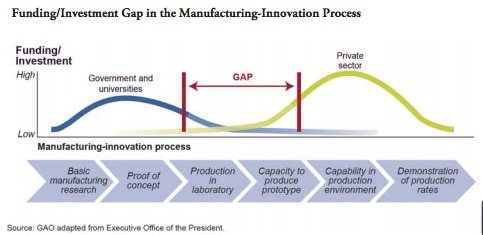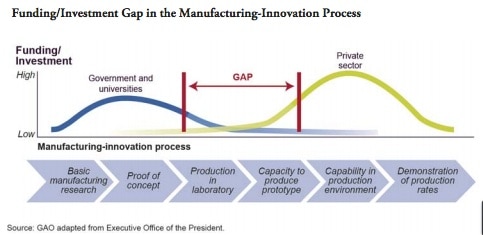
Here at Nanodot we often report on basic research that may lie on the path to atomically precise manufacturing, and we also frequently report on nanoscale science and technology research that promises near-term revolutionary developments in medicine, computation, energy and other application areas, but we seldom have anything to say about the transition from research to commercial production. The United States Government Accountability Office (GAO) is worried about this same lack, and has identified an important nanotechnology policy gap. Last month Business Insider Australia reported “A New Report Warns That America May Lose The Nanotechnology Race“:
VACUUM TUBES, semiconductors and the internet have changed how we live; now nanotechnology promises a similar revolution. Nanocoatings that make it impossible for liquid to even touch a treated surface are transforming material science. Carbon nanotubes can help artificial muscles behave like the real thing, while nanoscale drug delivery can target cancer cells with deadly accuracy. Concrete infused with nanofibres can be self-sensing, enabling roads and bridges to be monitored remotely for structural weakness or traffic volumes. …
It is this breadth of nanotechnology’s potential that makes it vital to America’s future competitiveness. Congressman Lamar Smith, chairman of the House Committee on Science, Space, and Technology, believes that American dominance in the field has enormous economic potential and the ability to create new jobs: “it’s a game-changer that could transform and improve Americans’ daily lives in ways we can’t foresee,” he says.
On any measure — patents, private and government-sector investment, academic activity — America has so far been a leader in nanotechnology research and, to a lesser extent, development. …
So why is the United States Government Accountability Office (GAO), an independent agency that works for Congress and scrutinises how the federal government spends taxpayer dollars, now fretting that America may lose the nanotechnology race? In a new report on nanotechnology manufacturing (or nanomanufacturing) released today and prepared for Congressman Smith’s committee, the GAO finds flaws in America’s approach to many things nano. …
The article goes on to describe the GAO’s concern with “the missing middle” between basic research and laboratory scale prototypes on one hand, production at commercial scale on the other. This missing middle includes things like reliable manufacturing processes, and in the case of healthcare, clinical trials. The report also cites unfortunate policy lapses, like the lack of a grand nanomanufacturing strategy, failure to match competition from Russia and China, and failure to develop and adequately fund “nano-commons” where research, design, prototyping, and manufacturing can mutually profit from close proximity to each other.
Congressman Smith, unsurprisingly, believes there’s an Act for that — specifically the wordy but acronym-friendly Technology and Research Accelerating National Security and Future Economic Resiliency (TRANSFER) Act of 2013, which he co-sponsored. “The bill”, he believes, “will give researchers and universities incentives to partner with entrepreneurs and venture capitalists in order to move new technologies from the laboratory to the marketplace”.
The 125-page GAO report Nanomanufacturing: Emergence and Implications for U.S. Competitiveness, the Environment, and Human Health grew from a forum convened by the GAO in July 2013. A introductory paragraph states:
Although limited data on international investments made comparisons difficult, participants viewed the U.S. as likely leading in nanotechnology research and development (R&D) today. At the same time, they identified several challenges to U.S. competitiveness in nanomanufacturing, such as inadequate U.S. participation and leadership in international standard setting; the lack of a national vision for a U.S. nanomanufacturing capability; some competitor nations’ aggressive actions and potential investments; and funding or investment gaps in the United States … which may hamper U.S. innovators’ attempts to transition nanotechnology from R&D to full-scale manufacturing.
The report quite reasonably focuses on the nanomanufacturing gap that stands between advancements in current and near-term nanoscience and nanotechnology, on the one hand, and large-scale commercial developments, on the other. But in addition to near-term nanomanufacturing that will grow out of incremental advances in several areas of nanoscience, there is the component of advanced nanomanufacturing that has a longer development path, but will (IMHO) dominate the economy before mid-century. My quick search of the document did not turn up any mention of “molecular manufacturing”, “atomically precise manufacturing”, or “productive nanosystems”. A comprehensive view of the impact of nanotechnology on US competitiveness must (IMHO) embrace both incremental progress in nanomanufacturing for current and near-term applications, and advancement of nanomanufacturing ability to the ultimate limits of high throughput atomically precise manufacturing. For the history of why the U.S. lacks a national vision for advanced nanomanufacturing, check out chapter 13 “A funny thing happened on the way to the future …” of Eric Drexler’s 2013 book Radical Abundance [see also TEDx talk: “Transforming the Material Basis of Civilization”].
—James Lewis, PhD
